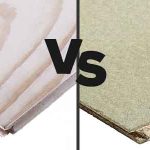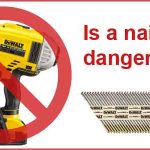In this article we will be looking at whether you should nail or screw floorboards. In most older properties floorboards are nailed. There are several reasons for this, the main ones being:
- Fixing with screws takes longer than nailing, even when using a cordless drill/driver.
- Affordable cordless drills that could fix screws, were not available until the late 60’s early 70’s. This means any boards laid before then would be nailed. Even when they had these tools, nailing would usually be the faster option.
- The Philips head screw wasn’t invented till the 1930’s. This means that any screws prior to this, were flat head and slightly more difficult to fix. Therefore, they would have taken even longer to screw.
- Nails tend to be cheaper than screws, so most contractors would opt for the cheaper and faster option.

As you can see, even with modern tools, nailing is faster and cheaper than screwing. This is even more true if you have access to a nail gun, which can fix nails much faster than a drill screw. However, just because it is slightly quicker and cheaper, that doesn’t mean it’s always the best option.
There really is no right or wrong answer, and you can use either. However, screws are slightly superior when it comes to fixing floorboards. They provide a better fixing and are much easier to remove or replace at a later date.
The fact that they can be unscrewed gives them an advantage over nails in this regard. If you need to remove nailed floorboards, you will need a crowbar. This will be more awkward and time consuming.
Advantage of screwing floorboards
There are several advantages to screwing floorboards. Therefore, if the boards will be covered by carpets or another type of flooring, it is worth considering screws over nails.
So, what are the main advantages?
- Ease of removal – The main advantage of screwing floorboards is they are far easier to remove at a later date. This could be necessary for several reasons, such as accessing water pipes and electrical wires below the floor. It can also make it quicker and easier to carry out repairs, or entire floorboard replacement.
- Better more solid fixing – Due to the thread on a screw, they pull the boards much tighter to the joist. This reduces movement and will prevent the dreaded squeaky floorboard. Nails allow far more movement, as a result, the boards are more prone to squeaking, especially over longer periods of time.
In fact, if you do have squeaky floorboards, a screw will often resolve the problem. Even one or two screws in a nailed floorboard can usually do the trick.
Advantage of nailing floorboards
Whilst screwing floorboards does have its advantages, it is less convenient, and many people will still prefer to nail boards. Ideally you should weigh up the pros and cons of each and choose accordingly.
So, what are the advantages of nailing floorboards?
- Its faster – Even when you nail boards manually it can be faster than screwing. With that said, a trades person with experience, will have skill and speed to fix nails quickly. If you are unskilled and slowly hammering nails in, screwing might not take much longer.
However, if you are using a nail gun, this will make the job much faster. A nail gun doesn’t really require any skill and you can nail an entire board in seconds. - It’s usually cheaper – Generally nails are cheaper than screws and this means you can get more fixings at a lower cost. This isn’t necessarily true for nail gun nails. However, time is money, and the speed easily makes up for any slightly higher cost.
- Don’t need a lot of expensive tools – This comes back to being cheaper, and if you do decide to manually nail boards, all you need is a reasonably good hammer. If you’re screwing you will need a cordless drill, and this could set you back £100+ for anything half decent.
- Easier to do hidden fixings – There are instances where you may want to hide fixings. The main reason for this would be leaving the boards exposed. The most common way to do this is with a flooring nailer. This tool allows you to fix through the front and tongue of the floorboard. By doing this the nails are hidden by the next board. This would be far more difficult to achieve with screws.
Conclusion
As you can see, there are several pros and cons, to both nails and screws. Therefore, there isn’t really a right or wrong answer for which you should choose. Ideally you should way up the advantages and disadvantages of each to make your decision.
You could even opt for a combination of both. For example, you could nail the majority of boards and screw down boards where you know there are services, such as water and electric running below. This would make the overall job quicker, as you could nail most of the boards down. But it could also help to make access to services easier at a later date.
However, in reality you will probably choose one or the other. So just weigh up the pros and cons and choose whichever option you prefer. Just be aware, if you do opt for nails, there is a chance you will end up with some squeaky boards. Also, you will need to use a crowbar if you ever need to take the boards up.
If you are just carrying out a small repair or fixing a squeaky board, then screwing would be the obvious first choice. On one or two boards, the time difference screwing would be minuscule, and it would almost guarantee no squeaky boards.




